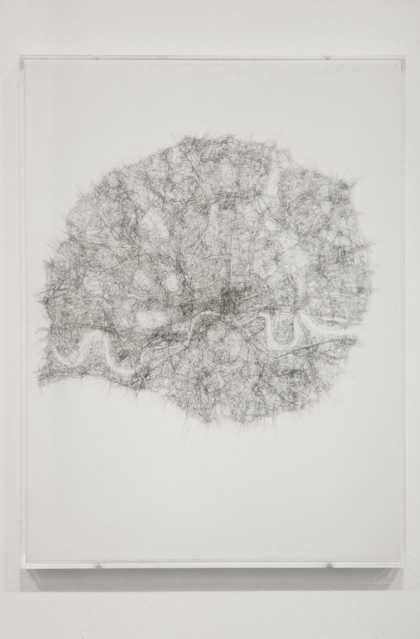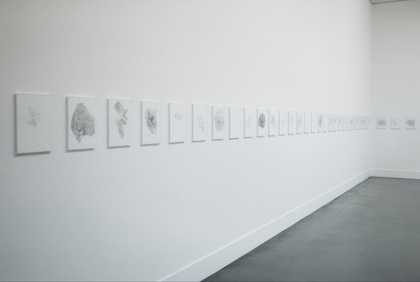Prendergast’s City Drawings are based on contemporary maps of the world’s capital cities. However, she deliberately by-passes systems of orientation and classification, divesting her source material of its coded information and merely transcribing, in each case, the network of lines that conveys the pattern of routes through, within and around each city.
Prendergast began this series in 1992, interested in working on a sustained long-term project, as opposed to the piece by piece basis of her early work. She had previously used maps, grafting imaginary locations on to images, often of the female body, and intending the viewer to ‘read’ the body as landscape. The City Drawings reverse this approach. The map no longer offers itself as a narrative, or indeed as an interpretative tool, but is instead transformed by drawing into a zone of the imagination. This practice relates as much to a long history of artists using map images as a way of accessing states of mind and the unknown as it does to conventional map making.
The series was initiated and has unfolded during a time of world political instability. Nations and cities, in the former Soviet Union or Yugoslavia for example, have come into being and others have disappeared, so that we have become accustomed to hearing of important events in unknown locations. For the most part Prendergast’s cities remain unknown to us. Without the level of information carried by the typical A-Z, or without what Italo Calvino’s Marco Polo described in the novel Invisible Cities as the city’s ‘thick coating of signs’ we are unable to give her places names but we are nevertheless able to infer something of their individual histories: tightly-knit medieval cities are encircled by the open grid of modern town planning. At the point where flat land meets a mountain range, a coastline or a river, the momentum changes as design submits to nature.
Prendergast’s City Drawings are tiny skeletal images in which even the largest and most powerful communities are reduced to a frail network of lines. Prendergast works with a B pencil in a light, almost anonymous style on small sheets of paper taken from a sketchpad. She draws from the centre of each page with the city on a North-South axis. Because the immense disparities in scale between cities are impossible to represent in so compressed a form Prendergast has worked intuitively, following her own sense of scale and allowing the smaller cities to float amoeba-like on the page while the great conurbations threaten the edges of the paper. The drawings are regularly disposed in a line around the room at head height, inviting close and prolonged scrutiny. Like anonymous portraits, they are sites for speculation and fantasy. Aside from evidence of character and of lived experience we read the drawings through resemblance: resemblance to each other and to a generic notion of the city. But also to other things: patterns and textures in nature, such as finger prints, organic structures and microscopic life forms. Prendergast offers this as a form of knowledge, derived through curiosity and imagination, in place of the kind of factual information we normally associate with maps. Each drawing traces the imprint of history, recording a moment in a process of organic growth. As cities continually evolve, each drawing remains in a sense unfinished and this ambitious project, currently a work-in-progress, could continue for as long as there are borders of national identity to redefine.
Text written by Frances Morris
Biography
Born 1958 in Dublin, graduated NCAD, Dublin 1980 and RCA, London 1986, lives and works in London.
Programme
The 1996-7 exhibition programme is supported by the Hanry Moore Foundation, the Patrons of Fine Art and an anonymous donor.




